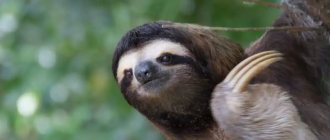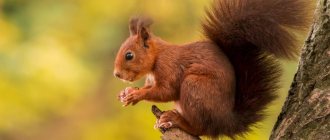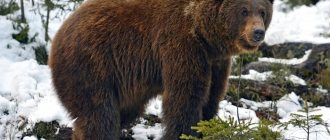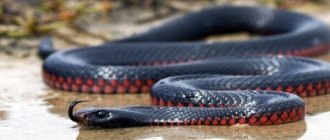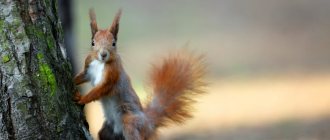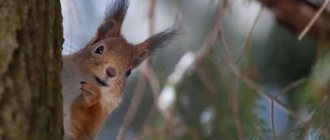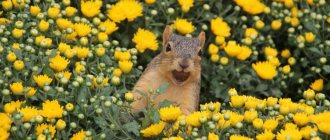Common squirrel: description
This rodent represents the squirrel family and has another name - wecksha, although few people use it nowadays. There are up to 30 species of this family in the world, distributed throughout the globe, and only the common squirrel lives in our open spaces.
Appearance
The squirrel is a rather nimble animal with a slender, proportional body, at the end of which you can see a rather long and fluffy tail, from 13 to 19 cm long, which reaches 2/3 of the entire body length. Squirrels of all types, including the common squirrel, have common features. The tail appears flattened due to long hairs sticking out in different directions.
This rodent grows to a maximum length of 30 cm, while gaining a weight of no more than 400 grams. The squirrel has a round head with dark, bead-shaped eyes, as well as long ears, at the end of which there are tassels sticking up, which become more noticeable in winter.
Vibrissae are highly sensitive and decorate both the muzzle and the front legs and abdomen. The squirrel's belly is always lighter, or has a pure white tint, compared to the upper part of the animal. The hind limbs of the squirrel are much longer than the front ones, and all the paws are armed with rather sharp and tenacious claws.
It is important to know! The overall size of the common squirrel depends on its habitat. The further north the region is located, the smaller the animal is. The same can be said about the color of the squirrel, which becomes lighter towards the north.
Before the onset of winter, the squirrel grows quite tall and thick fur, which cannot be said about the summer period, when its fur is short, sparse and hard.
Character of color
The color of the common squirrel can vary quite widely, depending on the season, subspecies, and even depending on the population boundaries of individual species.
In summer, the color of the coat is distinguished by darker tones, maintained in brown, red or dark brown shades. In winter, their color is more reminiscent of gray shades, and sometimes almost black. Among squirrels, there are individuals whose fur is diluted with light spots (piebald), as well as individuals with almost black fur (melanists) or specimens lacking color (albinos).
The Far Eastern, Carpathian and Manchurian subspecies are distinguished by more brown tones, including blacker ones, especially in winter. Teleut squirrels, which represent the largest subspecies of squirrels living in our territory, are silver-gray, pale gray or bluish in winter.
Telet squirrels are also called greytail squirrels due to the color of their tail in winter. In addition, squirrels are divided into “brown-tailed”, “red-tailed” and “black-tailed”.
Shedding
The squirrel, like many other animals with fur, molts twice a year, while the tail changes its coat only once a year. As a rule, the molting process occurs in the spring, in April/May, and in the fall, in September/November.
The molting process in animals is controlled by the length of daylight hours, which affects the functions of the pituitary gland. The pituitary gland begins to produce thyrotropin, which affects the function of the thyroid gland, and it starts the molting process.
Interesting Facts! Adult males always begin to molt earlier, compared to adult females, as well as juveniles that were born in the current year. Shedding in spring begins from the head, and autumn shedding begins from the tail.
Molting periods may vary depending on the availability of food supply, as well as the temperature conditions of the region. If there is a food supply, the molting process starts earlier and ends earlier, but if there is a lack of food, this process can last indefinitely.
Squirrel and interesting facts about it
Dimensions
Below is information about the weight and size of some varieties of squirrels.
| Variety | Weight, g | Body length, cm | Tail length, cm |
| Western gray | 942 | 50 | 30 |
| Goldenbellied | 505 | 25,8 | 25,5 |
| Allen's squirrel | 470 | 26,7 | 20,8 |
| Persian | 430 | 25,5 | 17 |
| Växa | 340 | 28 | 19 |
| Japanese | 250 | 22 | 17 |
| Guiana | 180 | 20 | 18,3 |
Lifestyle and behavior
The common squirrel does not mark its territory, like some animals, so several individuals can live in one territory. The squirrel prefers to spend most of its time in trees, and this rodent is most active in the morning and evening hours. At this time of day, she is busy looking for food for herself, spending almost all her free time on this. In case of danger, the animal hides in the crown of trees.
The squirrel easily jumps from tree to tree, covering up to 4 meters in a straight line and at least 15 meters in a downward arc. Her tail serves as a rudder. In winter, it moves more in the trees, and during the mating season, and also when there is no snow, it can also move along the ground, jumping up to 1 m in length.
In the dead of winter, when there are severe frosts or heavy snowfalls and blizzards outside, the common squirrel is in its shelter, and it can leave it only in case of severe hunger.
Habitats
Almost everyone knows that squirrels live in trees. At the same time, they look for trees with hollows, where they arrange a home for themselves. To do this, they fill the hollow with lichen, dry grass and leaves.
The nest can be located at a height of up to 15 meters, among dense branches. The diameter of the nest reaches more than 30 centimeters and has the shape of a ball.
Interesting to know! Squirrels often occupy the nests of various birds so as not to waste time building their own nest. Males, especially, do not engage in this important task, but settle in nests left by females, as well as in nests left by various birds.
Experts noticed that each squirrel has several nests, moving from one nest to another every few days. The female drags her offspring in her teeth. In winter, several individuals can live in one nest, although they prefer to lead a solitary lifestyle.
Migrations
It has long been known that proteins often carry out long migrations. As a rule, this process begins in late summer, early autumn and is associated with various natural disasters, such as fires, droughts, as well as lean years associated with the availability of basic squirrel food.
Naturally, they do not travel over a distance of more than 200 kilometers, and their movements are limited to nearby forests.
The movements are characterized by the fact that the migration front of the squirrels stretches for hundreds of kilometers, despite the fact that the squirrels move almost one by one. At the same time, they can flock together in the presence of natural obstacles.
During the migration process, proteins are able to overcome:
- Steppes.
- Tundra and forest-tundra.
- Various islands.
- Rivers and sea bays.
- Mountains.
- Settlements.
The migration of squirrels has quite negative consequences, since squirrels die from hunger, from cold, and also from the fact that they are hunted by various predators.
There are also seasonal migrations, which are associated with the fact that young animals begin an independent life, and food items do not mature overnight. At the same time, seasonal migrations in lean years can develop into large-scale movements.
In August/September, large-scale dispersal of young animals occurs, with individuals leaving their native nests and moving away from them to a distance of up to 70-300 km.
Some adults still remain, but they have to switch to feeding on low-calorie, high-fiber vegetation. For example:
- They feed on lichens.
- Buds of various plants.
- Bark of young shoots.
- Needles.
Those juveniles that remain will subsequently become the basis for replenishing the local squirrel population.
Squirrel lifespan
In natural conditions, only 10 percent of individuals survive to the age of 4 years. When kept in captivity, these rodents can live for at least 10 years.
Natural habitats
The range of the common squirrel, which represents one of 40 subspecies, extends to the boreal zone of Eurasia, starting from the shores of the Atlantic Ocean and ending with Kamchatka, Sakhalin and Island. Hokkaido. The squirrel is found in Siberia, the Far East, and also in the European part of Russia. The first squirrels appeared in Kamchatka somewhere at the beginning of the last century. This type of rodent feels good in the Tien Shan, the Caucasus and Crimea, where the squirrel is found both in vineyards and orchards.
The common squirrel is a typical forest dweller that lives in mixed coniferous-deciduous plantations, where there is enough food in the form of seeds of various tree species.
In addition, the squirrel takes great pleasure in settling in:
- In the cedar forests.
- In the thickets of dwarf cedar.
- In the spruce forests.
- In thickets of deciduous trees.
- In fir forests.
- In the pine forests.
Scientists have determined that squirrel populations decrease markedly closer to northern territories, where pine and deciduous woodlands are found.
Lifestyle
Where do squirrels live? The animal is distributed on almost all continents of the globe. They prefer dense deciduous and spruce forests. Here they feel safe. Adults avoid areas that are too sunny and open areas.
The squirrels' home is a complex structure made of dry branches and sphagnum moss. Some individuals prefer to settle in a deep hollow. Here they feel protected from climatic conditions and predators.
The depth of the dwelling is from 50 to 70 cm. The width reaches 35 – 50 cm. This allows you to accommodate up to 5 cubs from one litter.
Wooden and straw nests have two exits. One of them is the main one, and the other is used as a spare one. This allows the squirrel to remain safe and sound during the visit of unexpected guests.
Nutrition of the common squirrel
The squirrel's diet includes up to 130 types of food items, although this animal prefers seeds of coniferous trees such as pine, spruce, Siberian cedar, larch and fir. In forests dominated by oak and hazel thickets, the squirrel happily gnaws nuts and acorns.
When the year is lean, the squirrel has to eat mostly non-basic food, so it destroys the buds and shoots of young trees, roots and tubers, lichens, berries, herbs and mushrooms, giving preference to the deer truffle.
In cases of food shortage, squirrels can easily become a pest, destroying the flower buds of spruce trees. When mating season begins, the squirrel turns into a predator, eating various larvae, eggs, chicks and small invertebrates.
The squirrel, like other types of rodents, prudently stores up food for the winter in the form of nuts, acorns, cones, etc., filling hollows with them or hiding them among the roots. She also dries mushrooms by hanging them on tree branches. Unfortunately, she does not remember the places where she hides her supplies for the winter, which is used by other forest inhabitants, such as bears, birds, etc.
Important fact! Despite the fact that the winter supplies that the squirrel has stored are often eaten by other animals and birds, the squirrel does not remain in debt and easily takes out supplies from under a half-meter layer of snow, stored for the winter by mice, chipmunks and nutcrackers.
After wintering, severe hunger forces this animal to eat the bones of dead small animals. During the day, this animal eats up to 80 grams of food in the summer, and no more than 35 grams in the winter.
Reserves
In summer, the squirrel's diet is varied and very rich. But in order not to experience hunger in the winter, she makes supplies, which speaks of her rather good intelligence. Basically, they consist of acorns, nuts and nests dried among twigs. He can even put a whole cone in reserve.
Since squirrels have not one hollow with a nest, but several, they often have enough supplies to last the whole winter. Even with her poor memory, she always comes across something to snack on.
Some forest inhabitants, for example, other types of rodents or birds, can take advantage of its reserves and feast on them during the difficult and cold time of winter. Proteins basically do the same thing. Having a certain supply of food, they still go out in search of food and often, finding other people’s supplies under the snow, do not disdain them, but, on the contrary, take everything for themselves.
The process of reproduction and the appearance of offspring
Squirrels are different in that they can reproduce up to 2 times a year, and in warmer regions up to 3 times. The only exception is the Yakut squirrel, which breeds only once a year. The mating season for squirrels begins depending on habitat conditions and is tied to a specific area. The beginning of the breeding season is characterized by the onset of January-March and ends in July-August.
As a rule, females have a sufficient number of suitors and she has to choose from half a dozen males, who at this time make characteristic sounds, attracting the female, and also chase each other and actively knock on tree branches with their paws. Having chosen a male for herself, the female is fertilized, after which she begins to build a spacious and neat nest, and sometimes several nests. After about 40 days maximum, offspring are born.
Interesting to know! After the squirrel feeds its first offspring, it replenishes its body with nutrients and mates again. The interval between broods is about 13 weeks. With the arrival of autumn, the population of baby squirrels mainly consists of individuals born this year.
The first birth consists of 3-10 baby squirrels, which are absolutely helpless, naked and blind. Their weight is no more than 8 grams each. There are always fewer babies in the second litter. After a couple of weeks, the juveniles begin to become covered with fur, and after a month their eyes open. During this period, they can already crawl out of the nest.
The female feeds them milk for almost 2 months, after which the babies can already leave their mother. After a year or a little earlier, the squirrels become sexually mature.
Keeping at home
Since the squirrel is a very cute animal, it is not surprising that sometimes people keep them in captivity. When keeping a squirrel at home, it is important to create suitable living conditions for it. Since the squirrel is an active rodent, it needs a spacious enclosure with a length and width of at least half a meter. The enclosure should have a nest or birdhouse, branches on which the squirrel will jump, and shelves on which it will sit.
It is also, of course, very important to provide the squirrel with proper nutrition. You can feed this animal with fresh or dried mushrooms, pine nuts, acorns, and hazelnuts. Cones with seeds will also please the squirrel. To compensate for protein deficiency, it will be useful to give your pet chalk or eggshells.
With enough perseverance, you can train a squirrel to eat from your hand. It is important that you should not feed the squirrel peanuts and salted seeds, they are harmful to it.
Natural enemies of squirrels
The common squirrel is attacked by various predators. For example:
- Pine marten.
- Goshawk.
- Fox.
- Owls.
- Sable.
- Kharzy.
- Wild cats.
According to scientists, the squirrel's natural enemies are not able to harm its population. Much more dangerous is the lack of feed, as well as various diseases. As a rule, diseases appear at the end of autumn, but they are most frequent in the spring. Squirrels are parasitized by various pests, such as ticks, fleas and worms. In this regard, a lot of protein dies from tularemia, coccidiosis, as well as hemorrhagic septicemia.
Video
And in conclusion, a very interesting documentary about the unusual abilities of squirrels - “Super Squirrels”.
Author: Pavel Chaika, editor-in-chief of Poznavaika magazine
When writing the article, I tried to make it as interesting, useful and high-quality as possible. I would be grateful for any feedback and constructive criticism in the form of comments on the article. You can also write your wish/question/suggestion to my email [email protected] or Facebook, with respect, the author.
Author page
Commercial significance
The common squirrel is a valuable fur-bearing animal, and therefore is a key object of the fur trade. It is hunted in the forests of the European part of our country, in the Urals, Yakutia, Siberia and the Far East.
Just recently, some fifty years ago, in terms of the volume of fur harvested, squirrels were second only to sable. This has led to the fact that nowadays the acceptance of pelts from this animal has sharply dropped, and since 2009, squirrel pelts are not even put up for auction at fur auctions.
Where do they live?
The habitat of squirrels covers all continents with the exception of Australia and Antarctica. Most species are common in taiga, deciduous and mixed forests. Squirrels are also found in such natural areas as tropical rainforests, evergreen subtropical forests, monsoon forests
Where live
Suitable habitat for squirrels is dense lowland forests and ribbon forests with a sufficient number of tall trees, as well as old trees with hollows. Some species (Santander squirrel, Deppe squirrel, red-tailed squirrel) are able to live in mountain forests located at an altitude of 2-4 thousand meters above sea level.
Population and species status
Populations of the common squirrel are particularly influenced by the food supply. As a rule, after a fertile year, the birth rate of squirrels increases significantly, almost 400 percent. But after a lean year, the number of this animal drops tenfold.
The number of squirrels per 1 thousand hectares depends on many factors, but the main one is still considered to be the availability of food supply. Therefore, in the Moscow region this indicator is at the level of 30-80 squirrels per 1 thousand hectares, and already in Eastern Siberia it reaches a value of 100 to 290 individuals per 1 thousand hectares. The highest population density is observed in cedar forests, where there are up to five thousand individuals per 1 thousand hectares.
Interesting Facts! In Ireland and England, the gray squirrel, introduced into the forests, replaced the common squirrel, infecting it with a dangerous poxyvirus. In the Caucasus, on the contrary, the introduced common squirrel replaced the Persian squirrel, which had lived in these parts for many centuries.
In places where squirrel fishing is practiced, the number of this animal is restored within a maximum of 4 years. Under the same conditions, catastrophic mortality of young individuals is observed, 3 quarters of which do not survive the first winter.
Habitats
Squirrels live everywhere: throughout Europe, most of Asia, Russia and even on many islands. However, you will not find it in Australia or Madagascar.
They prefer to settle in forest and park areas where trees grow abundantly. They adapt well to both cold and heat.
They take refuge in trees, most often choosing coniferous ones, but they will not disdain deciduous ones. They can change their home if the year turns out to be a bad harvest and settle in another place. They often live in cedar forests due to the abundance of their favorite foods.
It can easily get along with people, and perhaps sees this as a definite plus for itself - people usually feed these funny animals, especially in the cold.
Now you can have squirrels as a pet, but you should not bring them from the forest to your home. Such individuals will most likely die in unusual conditions or due to stress. They are also carriers of dangerous diseases that can be transmitted to humans. If you want to have this cute creature at home, be sure to buy it only in specialized stores and bring it home after examination by a veterinarian.
